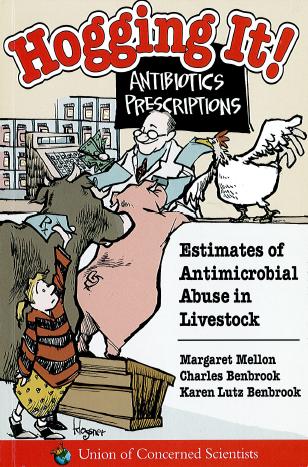Pork producers are trumpeting the findings of a new study, led by Dr. Michael Apley of Kansas State University, which estimates that the industry is giving some 2.8 million pounds of medically important antibiotics to pigs each year. This is much less than the 10.3 million pounds UCS estimated back in 2000 with our report, Hogging It: Estimates of Antimicrobial Abuse in Livestock. The Apley study deserves attention, but it doesn’t settle the issue of how much antibiotics the pork industry is using.
UCS has long advocated for more and better data on antibiotic use in agriculture. Frustrated with the lack of official data, we produced Hogging It more than a decade ago to fill the gap and make the point that the government wasn’t doing its job.
But UCS did not want to be in the drug data business. The major recommendations of the report were pleas for the FDA and the USDA to set up badly-needed systems to collect, compile and publish comprehensive antibiotic use data.
Ten years later we are somewhat better off. The FDA, ordered by Congress, has published two years of drug sales and distribution data, which seem to validate our use estimates. But the government has no program to comprehensively compile and regularly publish data on how those drugs are used. So, we still don’t know for sure which animals are getting which antibiotics for what purpose, or whether uses are going up or down.
The Apley report, like Hogging It before it, steps into the breach and attempts to do what the government isn’t—calculating quantities of on-farm use. The Apley team uses methodology developed by Hogging It author Chuck Benbrook and plugs in information based on responses to a 2006 survey conducted by the National Animal Health Monitoring System (NAHMS). It then supplements NAHMS data with survey responses from 27 veterinarians with expertise on swine.
The Apley group came up with an estimate of 2.8 million pounds per year for all uses of medically important antibiotics in swine compared to the Hogging It estimate of 10.3 million pounds for nontherapeutic use of medically important antibiotics.
The Apley report does not compare its estimates to the Hogging It, but others have. The National Pork Producers Council says the study shows “opponents of antibiotic use in livestock wildly overestimate the amount given to food animals” and suggests that Hogging It be renamed Fabricating It.
But scientifically, just because the estimates are different doesn’t mean one or the other is correct.
Both estimates are admittedly imperfect. UCS was very upfront about the limits of the numbers in Hogging It. And so is the Apley paper. The authors of the paper (admirably) check for accuracy by consulting three companies of swine-only feed additives. Two said their sales in 2006 were close to the numbers calculated by the paper, but one said that the study’s estimate represented only 40 percent of its sales–off by more than 100 percent. If the estimates for any heavily used drug are off by that much, it would make a big difference in the total estimate.
The differences in the two estimates could also reflect changes in industry use from the late 1990s to 2006. I have been told privately for years that pork producers have reduced antibiotic use. Maybe it’s true.
On the other hand, very low numbers for use in the swine industry are hard to square with the sales figures compiled by FDA, which report 28 million pounds of animal antimicrobials in 2009. That number, which covers both medically important and non-medically important antimicrobials for all uses, is consistent with the Hogging It number of 24 million pounds for swine, poultry and beef for non-therapeutic purposes.
In a letter to Congresswoman Louise Slaughter, FDA broke out the total data for 2009 by mode of administration, reporting that 22 million pounds of antimicrobials were being used in feed; the rest was being given by water or injection. If only 13 percent (2.8 of 22 million) of the total in feed drugs sold in the United States is being used in swine, what is happening to the other 87 percent? What are those poultry and beef folks up to?
Moreover, the Apley team reported that growth promotion and disease prevention account for only 57 percent of the in-feed use in swine—much lower than earlier estimates of 90 percent for those uses.
Long term, neither the Union of Concerned Scientists nor Kansas State University ought to be in the data collection business. Neither has the resources or mission to collect data year after year, employing a standard methodology and sophisticated surveying techniques. This is a job for the federal government, specifically the USDA and FDA working together.
We won’t know whether the Apley or the UCS estimates are more representative of actual use until we can compare them to comprehensive, government-generated data. Rather than throwing around epithets, we should all be united behind that goal.

